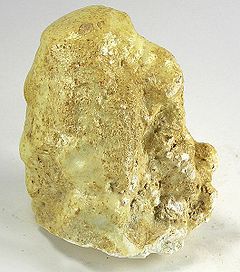Copiapite
| Copiapite | |
|---|---|

Copiapite from the Bolesław Mine, Kłodzko District, Lower Silesia, Poland
|
|
| General | |
| Category | Sulfate minerals |
|
Formula (repeating unit) |
|
| Strunz classification | 7.DB.35 |
| Crystal system | Triclinic |
| Crystal class | Pinacoidal (1) (same H-M symbol) |
| Space group | P1 |
| Unit cell | a = 7.337 Å, b = 18.76 Å, c = 7.379 Å; α = 91.47°, β = 102.18°, γ = 98.95°; Z = 1 |
| Identification | |
| Color | Sulfur-yellow to orange when crystalline, greenish-yellow to olive-green when massive |
| Crystal habit | Tabular pseudo-orthorhombic platy crystals, typically in scaly incrustations or granular pulverulent aggregates |
| Twinning | Contact twins |
| Cleavage | Perfect on {010}, imperfect on {101} |
| Fracture | Irregular/uneven, micaceous |
| Tenacity | Fragile |
| Mohs scale hardness | 2.5 - 3 |
| Luster | Pearly on {010} |
| Diaphaneity | Transparent to translucent |
| Specific gravity | 2.04–2.17 |
| Optical properties | Biaxial (+) |
| Refractive index | nα = 1.506 - 1.540 nβ = 1.528 - 1.549 nγ = 1.575 - 1.600 |
| Birefringence | δ = 0.069 |
| Pleochroism | X = Y = pale yellow to colorless; Z = sulfur-yellow |
| 2V angle | Measured: 45° to 74°, Calculated: 48° to 72° |
| Solubility | Soluble in water |
| References | |
Copiapite is a hydrated iron sulfate mineral with formula: Copiapite can also refer to a mineral group, the copiapite group.
Copiapite is strictly a secondary mineral forming from the weathering or oxidation of iron sulfide minerals or sulfide-rich coal. Its most common occurrence is as the end member mineral from the rapid oxidation of pyrite. It also occurs rarely with fumaroles. It occurs with melanterite, alunogen, fibroferrite, halotrichite, botryogen, butlerite and amarantite. It is by far the most common mineral in the copiapite group.
...
Wikipedia

